Seepage Analysis in Short Embankments Using Developing a Metaheuristic Method Based on Governing Equations
Abstract
1. Introduction
- (1)
- Investigating different conditions of the seepage rate in the environment;
- (2)
- Implementing the equations governing the seepage rate and different generating models;
- (3)
- Developing neural models;
- (4)
- Presenting new approaches to evaluating the seepage rate as alternative solutions to the equations previously presented in the literature.
2. Research Methodology
2.1. Theory and Data Collection
2.1.1. Dupuit’s Method
2.1.2. Schafferank and van Iterson Method
2.2. Prediction Models
2.2.1. Artificial Neural Network (ANN)
2.2.2. Invasive Weed Optimization (IWO)
- (1)
- First, at the “population initialization” step, several seeds are randomly distributed within the search space.
- (2)
- At the “reproduction” step, every plant is poured into a flowering plant; after that, the system can produce seeds that are worth their proportion. Then, the quantity of the seeds is linearly reduced from Smax to Smin with the use of the following equation:
- (3)
- At the third step, a new position of the seeds within the search space is determined. At this step, the child’s seeds are positioned nearby their parents.
- (4)
- At the fourth step, which is referred to as the competitive elimination step, the best seeds are created based on their merit. It takes place in the case that a certain number (Pmax) of seeds have been created.
- (5)
- Finally, at the fifth step, if the termination criterion is not satisfied yet, the whole process is repeated from the second step to the end. It continues until the termination criterion is met, and the algorithm operation will then end. Figure 4 illustrates a general diagram showing the steps involved in an IWO operation.
2.2.3. Hybrid Algorithms
3. Simulation Models
3.1. Initial Model
3.2. Hybrid Model Development
4. Results and Discussion
5. Conclusions
Author Contributions
Funding
Conflicts of Interest
References
- Cryer, C.W. On the approximate solution of free boundary problems using finite differences. J. ACM 1970, 17, 397–411. [Google Scholar] [CrossRef]
- Taylor, R.L.; Brown, C.B. Darcy flow solutions with a free surface. J. Hydraul. Div. 1967, 93, 25–33. [Google Scholar]
- Finn, W.D. Finite-element analysis of seepage through dams. J. Soil Mech. Found. Div. 1967, 93, 41–48. [Google Scholar]
- Neuman, S.P.; Witherspoon, P.A. Finite element method of analyzing steady seepage with a free surface. Water Resour. Res. 1970, 6, 889–897. [Google Scholar] [CrossRef]
- Westbrook, D.R. Analysis of inequality and residual flow procedures and an iterative scheme for free surface seepage. Int. J. Numer. Methods Eng. 1985, 21, 1791–1802. [Google Scholar] [CrossRef]
- Baiocchi, C. Su un problema di frontiera libera connesso a questioni di idraulica. Ann. Mat. Pura Appl. 1972, 92, 107–127. [Google Scholar] [CrossRef]
- Bathe, K.; Khoshgoftaar, M.R. Finite element free surface seepage analysis without mesh iteration. Int. J. Numer. Anal. Methods Geomech. 1979, 3, 13–22. [Google Scholar] [CrossRef]
- Alt, H.W. Numerical solution of steady-state porous flow free boundary problems. Numer. Math. 1980, 36, 73–98. [Google Scholar] [CrossRef]
- Kikuchi, N. An analysis of the variational inequalities of seepage flow by finite-element methods. Q. Appl. Math. 1977, 35, 149–163. [Google Scholar] [CrossRef]
- Oden, J.T.; Kikuchi, N. Theory of variational inequalities with applications to problems of flow through porous media. Int. J. Eng. Sci. 1980, 18, 1173–1284. [Google Scholar] [CrossRef]
- Friedman, A.; Spruck, J. Variational and Free Boundary Problems; Springer Science & Business Media: Heidelberg, Germany, 2012; Volume 53, ISBN 1461383579. [Google Scholar]
- Baiocchi, C. Variational and quasivariational inequalities. In Applications to Free-Boundary Problems; Wiley: New York, NY, USA, 1984. [Google Scholar]
- Desai, C.S.; Li, G.C. A residual flow procedure and application for free surface flow in porous media. Adv. Water Resour. 1983, 6, 27–35. [Google Scholar] [CrossRef]
- Brezis, H. Sur une nouvelle formulation du problème de l’écoulement à travers une digue. CR Acad. Sci. Paris 1978, 287, 711–714. [Google Scholar]
- Borja, R.I.; Kishnani, S.S. On the solution of elliptic free-boundary problems via Newton’s method. Comput. Methods Appl. Mech. Eng. 1991, 88, 341–361. [Google Scholar] [CrossRef]
- Lacy, S.J.; Prevost, J.H. Flow through porous media: A procedure for locating the free surface. Int. J. Numer. Anal. Methods Geomech. 1987, 11, 585–601. [Google Scholar] [CrossRef]
- Bardet, J.P. Experimental Soil Mechanics; Prentice-Hall: Upper Saddle River, NJ, USA, 1997. [Google Scholar]
- Johansson, S. Seepage Monitoring in an Earth Embankment Dams. TRITA-AMI PHD 1014. Ph.D. Thesis, Royal Institute of Technology, Stockholm, Sweden.
- Bardet, J.-P.; Tobita, T. A practical method for solving free-surface seepage problems. Comput. Geotech. 2002, 29, 451–475. [Google Scholar] [CrossRef]
- Nourani, V.; Aminfar, M.H.; Alami, M.T.; Sharghi, E.; Singh, V.P. Unsteady 2-D seepage simulation using physical analog, case of Sattarkhan embankment dam. J. Hydrol. 2014, 519, 177–189. [Google Scholar] [CrossRef]
- Nourani, V. An emotional ANN (EANN) approach to modeling rainfall-runoff process. J. Hydrol. 2017, 544, 267–277. [Google Scholar] [CrossRef]
- Jianhua, Y. FE modelling of seepage in embankment soils with piping zone. Chin. J. Rock Mech. Eng. 1998, 17, 679–686. [Google Scholar]
- PS, M.A.; Balan, T.G.A. Numerical analysis of seepage in Embankment dams. IOSR J. Mech. Civ. Eng. 2014, 4, 13–23. [Google Scholar]
- Cho, S.E. Probabilistic analysis of seepage that considers the spatial variability of permeability for an embankment on soil foundation. Eng. Geol. 2012, 133, 30–39. [Google Scholar] [CrossRef]
- Le, T.M.H.; Gallipoli, D.; Sanchez, M.; Wheeler, S.J. Stochastic analysis of unsaturated seepage through randomly heterogeneous earth embankments. Int. J. Numer. Anal. Methods Geomech. 2012, 36, 1056–1076. [Google Scholar] [CrossRef]
- Calamak, M.; Yanmaz, A.M. Probabilistic assessment of slope stability for earth-fill dams having random soil parameters. In Proceedings of the 11th National Conference on Hydraulics in Civil Engineering & 5th International Symposium on Hydraulic Structures: Hydraulic Structures and Society-Engineering Challenges and Extremes, Brisbane, Australia, 5–7 November 2014; p. 34. [Google Scholar]
- Salas, J.D. Applied Modeling of Hydrologic Time Series; Water Resources Publication: Chelsea, MI, USA, 1980; ISBN 0918334373. [Google Scholar]
- Hajihassani, M.; Abdullah, S.S.; Asteris, P.G.; Armaghani, D.J. A Gene Expression Programming Model for Predicting Tunnel Convergence. Appl. Sci. 2019, 9, 4650. [Google Scholar] [CrossRef]
- Apostolopoulou, M.; Armaghani, D.J.; Bakolas, A.; Douvika, M.G.; Moropoulou, A.; Asteris, P.G. Compressive strength of natural hydraulic lime mortars using soft computing techniques. Procedia Struct. Integr. 2019, 17, 914–923. [Google Scholar] [CrossRef]
- Koopialipoor, M.; Ghaleini, E.N.; Tootoonchi, H.; Jahed Armaghani, D.; Haghighi, M.; Hedayat, A. Developing a new intelligent technique to predict overbreak in tunnels using an artificial bee colony-based ANN. Environ. Earth Sci. 2019, 78, 165. [Google Scholar] [CrossRef]
- Yang, H.; Koopialipoor, M.; Armaghani, D.J.; Gordan, B.; Khorami, M.; Tahir, M.M. Intelligent design of retaining wall structures under dynamic conditions. STEEL Compos. Struct. 2019, 31, 629–640. [Google Scholar]
- Chahnasir, E.S.; Zandi, Y.; Shariati, M.; Dehghani, E.; Toghroli, A.; Mohamed, E.T.; Shariati, A.; Safa, M.; Wakil, K.; Khorami, M. Application of support vector machine with firefly algorithm for investigation of the factors affecting the shear strength of angle shear connectors. SMART Struct. Syst. 2018, 22, 413–424. [Google Scholar]
- Katebi, J.; Shoaei-parchin, M.; Shariati, M.; Trung, N.T.; Khorami, M. Developed comparative analysis of metaheuristic optimization algorithms for optimal active control of structures. Eng. Comput. 2019, 1–20. [Google Scholar] [CrossRef]
- Zhou, J.; Li, X.; Shi, X. Long-term prediction model of rockburst in underground openings using heuristic algorithms and support vector machines. Saf. Sci. 2012, 50, 629–644. [Google Scholar] [CrossRef]
- Zhou, J.; Li, E.; Wang, M.; Chen, X.; Shi, X.; Jiang, L. Feasibility of Stochastic Gradient Boosting Approach for Evaluating Seismic Liquefaction Potential Based on SPT and CPT Case Histories. J. Perform. Constr. Facil. 2019, 33, 4019024. [Google Scholar] [CrossRef]
- Zhou, J.; Li, E.; Yang, S.; Wang, M.; Shi, X.; Yao, S.; Mitri, H.S. Slope stability prediction for circular mode failure using gradient boosting machine approach based on an updated database of case histories. Saf. Sci. 2019, 118, 505–518. [Google Scholar] [CrossRef]
- Zhou, J.; Li, X.; Mitri, H.S. Evaluation method of rockburst: State-of-the-art literature review. Tunn. Undergr. Space Technol. 2018, 81, 632–659. [Google Scholar] [CrossRef]
- Khandelwal, M.; Singh, T.N. Prediction of blast-induced ground vibration using artificial neural network. Int. J. Rock Mech. Min. Sci. 2009, 46, 1214–1222. [Google Scholar] [CrossRef]
- Zhou, J.; Guo, H.; Koopialipoor, M.; Armaghani, D.J.; Tahir, M.M. Investigating the effective parameters on the risk levels of rockburst phenomena by developing a hybrid heuristic algorithm. Eng. Comput. 2020, 1–16. [Google Scholar] [CrossRef]
- Asteris, P.; Roussis, P.; Douvika, M. Feed-forward neural network prediction of the mechanical properties of sandcrete materials. Sensors 2017, 17, 1344. [Google Scholar] [CrossRef]
- Monjezi, M.; Rizi, S.M.H.; Majd, V.J.; Khandelwal, M. Artificial neural network as a tool for backbreak prediction. Geotech. Geol. Eng. 2014, 32, 21–30. [Google Scholar] [CrossRef]
- Mahdiyar, A.; Jahed Armaghani, D.; Koopialipoor, M.; Hedayat, A.; Abdullah, A.; Yahya, K. Practical Risk Assessment of Ground Vibrations Resulting from Blasting, Using Gene Expression Programming and Monte Carlo Simulation Techniques. Appl. Sci. 2020, 10, 472. [Google Scholar] [CrossRef]
- Sayadi, A.; Monjezi, M.; Talebi, N.; Khandelwal, M. A comparative study on the application of various artificial neural networks to simultaneous prediction of rock fragmentation and backbreak. J. Rock Mech. Geotech. Eng. 2013, 5, 318–324. [Google Scholar] [CrossRef]
- Koopialipoor, M.; Fahimifar, A.; Ghaleini, E.N.; Momenzadeh, M.; Armaghani, D.J. Development of a new hybrid ANN for solving a geotechnical problem related to tunnel boring machine performance. Eng. Comput. 2020, 36, 345–357. [Google Scholar] [CrossRef]
- Al-Juboori, M.; Datta, B. Improved optimal design of concrete gravity dams founded on anisotropic soils utilizing simulation-optimization model and hybrid genetic algorithm. ISH J. Hydraul. Eng. 2019, 1–18. [Google Scholar] [CrossRef]
- Al-Juboori, M.; Datta, B. An Overview of Recently Developed Coupled Simulation Optimization Approaches for Reliability Based Minimum Cost Design of Water Retaining Structures. Open J. Optim. 2018, 7, 79–112. [Google Scholar] [CrossRef]
- Al-Juboori, M.; Datta, B. Optimum design of hydraulic water retaining structures incorporating uncertainty in estimating heterogeneous hydraulic conductivity utilizing stochastic ensemble surrogate models within a multi-objective multi-realisation optimisation model. J. Comput. Des. Eng. 2019, 6, 296–315. [Google Scholar] [CrossRef]
- Zhou, J.; Li, X.; Mitri, H.S. Comparative performance of six supervised learning methods for the development of models of hard rock pillar stability prediction. Nat. Hazards 2015, 79, 291–316. [Google Scholar] [CrossRef]
- Plevris, V.; Asteris, P.G. Modeling of masonry failure surface under biaxial compressive stress using Neural Networks. Constr. Build. Mater. 2014, 55, 447–461. [Google Scholar] [CrossRef]
- Liu, B.; Yang, H.; Karekal, S. Effect of Water Content on Argillization of Mudstone During the Tunnelling process. Rock Mech. Rock Eng. 2020, 53, 799–813. [Google Scholar] [CrossRef]
- Huang, L.; Asteris, P.G.; Koopialipoor, M.; Armaghani, D.J.; Tahir, M.M. Invasive Weed Optimization Technique-Based ANN to the Prediction of Rock Tensile Strength. Appl. Sci. 2019, 9, 5372. [Google Scholar] [CrossRef]
- Yang, H.Q.; Xing, S.G.; Wang, Q.; Li, Z. Model test on the entrainment phenomenon and energy conversion mechanism of flow-like landslides. Eng. Geol. 2018, 239, 119–125. [Google Scholar] [CrossRef]
- Yang, H.; Liu, J.; Liu, B. Investigation on the cracking character of jointed rock mass beneath TBM disc cutter. Rock Mech. Rock Eng. 2018, 51, 1263–1277. [Google Scholar] [CrossRef]
- Yang, H.Q.; Li, Z.; Jie, T.Q.; Zhang, Z.Q. Effects of joints on the cutting behavior of disc cutter running on the jointed rock mass. Tunn. Undergr. Space Technol. 2018, 81, 112–120. [Google Scholar] [CrossRef]
- Yang, H.Q.; Zeng, Y.Y.; Lan, Y.F.; Zhou, X.P. Analysis of the excavation damaged zone around a tunnel accounting for geostress and unloading. Int. J. Rock Mech. Min. Sci. 2014, 69, 59–66. [Google Scholar] [CrossRef]
- Asteris, P.G.; Kolovos, K.G.; Douvika, M.G.; Roinos, K. Prediction of self-compacting concrete strength using artificial neural networks. Eur. J. Environ. Civ. Eng. 2016, 20, s102–s122. [Google Scholar] [CrossRef]
- Armaghani, D.J.; Mohamad, E.T.; Narayanasamy, M.S.; Narita, N.; Yagiz, S. Development of hybrid intelligent models for predicting TBM penetration rate in hard rock condition. Tunn. Undergr. Space Technol. 2017, 63, 29–43. [Google Scholar] [CrossRef]
- Asteris, P.G.; Apostolopoulou, M.; Skentou, A.D.; Moropoulou, A. Application of artificial neural networks for the prediction of the compressive strength of cement-based mortars. Comput. Concr. 2019, 24, 329–345. [Google Scholar]
- Asteris, P.G.; Tsaris, A.K.; Cavaleri, L.; Repapis, C.C.; Papalou, A.; Di Trapani, F.; Karypidis, D.F. Prediction of the fundamental period of infilled RC frame structures using artificial neural networks. Comput. Intell. Neurosci. 2016, 2016, 20. [Google Scholar] [CrossRef] [PubMed]
- Chen, H.; Asteris, P.G.; Jahed Armaghani, D.; Gordan, B.; Pham, B.T. Assessing Dynamic Conditions of the Retaining Wall: Developing Two Hybrid Intelligent Models. Appl. Sci. 2019, 9, 1042. [Google Scholar] [CrossRef]
- Xu, H.; Zhou, J.; G Asteris, P.; Jahed Armaghani, D.; Tahir, M.M. Supervised Machine Learning Techniques to the Prediction of Tunnel Boring Machine Penetration Rate. Appl. Sci. 2019, 9, 3715. [Google Scholar] [CrossRef]
- Asteris, P.G.; Armaghani, D.J.; Hatzigeorgiou, G.D.; Karayannis, C.G.; Pilakoutas, K. Predicting the shear strength of reinforced concrete beams using Artificial Neural Networks. Comput. Concr. 2019, 24, 469–488. [Google Scholar]
- Koopialipoor, M.; Nikouei, S.S.; Marto, A.; Fahimifar, A.; Armaghani, D.J.; Mohamad, E.T. Predicting tunnel boring machine performance through a new model based on the group method of data handling. Bull. Eng. Geol. Environ. 2018, 78, 3799–3813. [Google Scholar] [CrossRef]
- Shahin, M.A.; Jaksa, M.B.; Maier, H.R. Artificial neural network applications in geotechnical engineering. Aust. Geomech. 2001, 36, 49–62. [Google Scholar]
- ASCE Task Committee on Application of Artificial Neural Networks in Hydrology. Artificial neural networks in hydrology. II: Hydrologic applications. J. Hydrol. Eng. 2000, 5, 124–137. [Google Scholar] [CrossRef]
- Al-Juboori, M.; Datta, B. Minimum Cost Design of Hydraulic Water Retaining Structure by using Coupled Simulation Optimization Approach. KSCE J. Civ. Eng. 2019, 23, 1095–1107. [Google Scholar] [CrossRef]
- Muqdad Al-Juboori, B.D. Predicting Exit Gradient of Water Retaining Structures: A Comparative Study of Five Machine Learning Techniques. Int. J. Adv. Mech. Civ. Eng. 2018, 5, 7–15. [Google Scholar]
- Tayfur, G.; Swiatek, D.; Wita, A.; Singh, V.P. Case study: Finite element method and artificial neural network models for flow through Jeziorsko earthfill dam in Poland. J. Hydraul. Eng. 2005, 131, 431–440. [Google Scholar] [CrossRef]
- Nourani, V.; Babakhani, A. Integration of artificial neural networks with radial basis function interpolation in earthfill dam seepage modeling. J. Comput. Civ. Eng. 2012, 27, 183–195. [Google Scholar] [CrossRef]
- Nourani, V.; Sharghi, E.; Aminfar, M.H. Integrated ANN model for earthfill dams seepage analysis: Sattarkhan Dam in Iran. Artif. Intell. Res. 2012, 1, 22–37. [Google Scholar] [CrossRef]
- Novakovic, A.; Rankovic, V.; Grujovic, N.; Divac, D.; Milivojevic, N. Development of neuro-fuzzy model for dam seepage analysis. Ann. Fac. Eng. Hunedoara 2014, 12, 133. [Google Scholar]
- Yongbiao, L. Prediction methods to determine stability of dam if there is piping. Leri Procedia 2012, 1, 131–137. [Google Scholar] [CrossRef][Green Version]
- Zhang, G.P. Time series forecasting using a hybrid ARIMA and neural network model. Neurocomputing 2003, 50, 159–175. [Google Scholar] [CrossRef]
- Shamseldin, A.Y.; O’Connor, K.M.; Liang, G.C. Methods for combining the outputs of different rainfall–runoff models. J. Hydrol. 1997, 197, 203–229. [Google Scholar] [CrossRef]
- Krogh, A.; Vedelsby, J. Neural network ensembles, cross validation, and active learning. In Proceedings of the Advances in Neural Information Processing Systems, Denver, CO, USA, 27–30 November 1995; pp. 231–238. [Google Scholar]
- Koopialipoor, M.; Ghaleini, E.N.; Haghighi, M.; Kanagarajan, S.; Maarefvand, P.; Mohamad, E.T. Overbreak prediction and optimization in tunnel using neural network and bee colony techniques. Eng. Comput. 2019, 35, 1191–1202. [Google Scholar] [CrossRef]
- Zhao, Y.; Noorbakhsh, A.; Koopialipoor, M.; Azizi, A.; Tahir, M.M. A new methodology for optimization and prediction of rate of penetration during drilling operations. Eng. Comput. 2019, 1–9. [Google Scholar] [CrossRef]
- Koopialipoor, M.; Fallah, A.; Armaghani, D.J.; Azizi, A.; Mohamad, E.T. Three hybrid intelligent models in estimating flyrock distance resulting from blasting. Eng. Comput. 2019, 35, 243–256. [Google Scholar] [CrossRef]
- Ghaleini, E.N.; Koopialipoor, M.; Momenzadeh, M.; Sarafraz, M.E.; Mohamad, E.T.; Gordan, B. A combination of artificial bee colony and neural network for approximating the safety factor of retaining walls. Eng. Comput. 2018, 35, 647–658. [Google Scholar] [CrossRef]
- Koopialipoor, M.; Armaghani, D.J.; Hedayat, A.; Marto, A.; Gordan, B. Applying various hybrid intelligent systems to evaluate and predict slope stability under static and dynamic conditions. Soft Comput. 2019, 23, 5913–5929. [Google Scholar] [CrossRef]
- Murty, V.V.N. Land and Water Management Engineering; Kalyani Publishers: Delhi, India, 2015. [Google Scholar]
- McCulloch, W.S.; Pitts, W. A logical calculus of the ideas immanent in nervous activity. Bull. Math. Biophys. 1943, 5, 115–133. [Google Scholar] [CrossRef]
- Mandal, S.K.; Singh, M.M. Evaluating extent and causes of overbreak in tunnels. Tunn. Undergr. Space Technol. 2009, 24, 22–36. [Google Scholar] [CrossRef]
- Zhou, J.; Koopialipoor, M.; Murlidhar, B.R.; Fatemi, S.A.; Tahir, M.M.; Armaghani, D.J.; Li, C. Use of Intelligent Methods to Design Effective Pattern Parameters of Mine Blasting to Minimize Flyrock Distance. Nat. Resour. Res. 2019, 1–15. [Google Scholar] [CrossRef]
- Engelbrecht, A.P. Computational Intelligence: An Introduction; John Wiley & Sons: Hoboken, NJ, USA, 2007; ISBN 0470512504. [Google Scholar]
- Armaghani, D.J.; Koopialipoor, M.; Marto, A.; Yagiz, S. Application of several optimization techniques for estimating TBM advance rate in granitic rocks. J. Rock Mech. Geotech. Eng. 2019, 11, 779–789. [Google Scholar] [CrossRef]
- Al-Juboori, M.; Datta, B. Performance evaluation of a genetic algorithm-based linked simulation-optimization model for optimal hydraulic seepage-related design of concrete gravity dams. J. Appl. Water Eng. Res. 2019, 7, 173–197. [Google Scholar] [CrossRef]
- Haykin, S.; Network, N. A comprehensive foundation. Neural Netw. 2004, 2, 41. [Google Scholar]
- Mohamad, E.T.; Koopialipoor, M.; Murlidhar, B.R.; Rashiddel, A.; Hedayat, A.; Armaghani, D.J. A new hybrid method for predicting ripping production in different weathering zones through in-situ tests. Measurement 2019, 147, 106826. [Google Scholar] [CrossRef]
- Koopialipoor, M.; Murlidhar, B.R.; Hedayat, A.; Armaghani, D.J.; Gordan, B.; Mohamad, E.T. The use of new intelligent techniques in designing retaining walls. Eng. Comput. 2020, 36, 283–294. [Google Scholar] [CrossRef]
- Xu, C.; Gordan, B.; Koopialipoor, M.; Armaghani, D.J.; Tahir, M.M.; Zhang, X. Improving Performance of Retaining Walls Under Dynamic Conditions Developing an Optimized ANN Based on Ant Colony Optimization Technique. IEEE Access 2019, 7, 94692–94700. [Google Scholar] [CrossRef]
- Mehrabian, A.R.; Lucas, C. A novel numerical optimization algorithm inspired from weed colonization. Ecol. Inform. 2006, 1, 355–366. [Google Scholar] [CrossRef]
- Bashir, Z.A.; El-Hawary, M.E. Applying wavelets to short-term load forecasting using PSO-based neural networks. IEEE Trans. Power Syst. 2009, 24, 20–27. [Google Scholar] [CrossRef]
- Lin, C.-J.; Hsieh, M.-H. Classification of mental task from EEG data using neural networks based on particle swarm optimization. Neurocomputing 2009, 72, 1121–1130. [Google Scholar] [CrossRef]
- Taghavifar, H.; Mardani, A.; Taghavifar, L. A hybridized artificial neural network and imperialist competitive algorithm optimization approach for prediction of soil compaction in soil bin facility. Measurement 2013, 46, 2288–2299. [Google Scholar] [CrossRef]
- Yagiz, S.; Karahan, H. Prediction of hard rock TBM penetration rate using particle swarm optimization. Int. J. Rock Mech. Min. Sci. 2011, 48, 427–433. [Google Scholar] [CrossRef]
- Jahed Armaghani, D.; Hasanipanah, M.; Mahdiyar, A.; Abd Majid, M.Z.; Bakhshandeh Amnieh, H.; Tahir, M.M.D. Airblast prediction through a hybrid genetic algorithm-ANN model. Neural Comput. Appl. 2018, 29, 619–629. [Google Scholar] [CrossRef]
- Momeni, E.; Nazir, R.; Armaghani, D.J.; Maizir, H. Prediction of pile bearing capacity using a hybrid genetic algorithm-based ANN. Measurement 2014, 57, 122–131. [Google Scholar] [CrossRef]
- Liou, S.-W.; Wang, C.-M.; Huang, Y.-F. Integrative Discovery of Multifaceted Sequence Patterns by Frame-Relayed Search and Hybrid PSO-ANN. J. UCS 2009, 15, 742–764. [Google Scholar]
- Guo, H.; Zhou, J.; Koopialipoor, M.; Armaghani, D.J.; Tahir, M.M. Deep neural network and whale optimization algorithm to assess flyrock induced by blasting. Eng. Comput. 2019, 1–14. [Google Scholar] [CrossRef]
- Koopialipoor, M.; Tootoonchi, H.; Jahed Armaghani, D.; Tonnizam Mohamad, E.; Hedayat, A. Application of deep neural networks in predicting the penetration rate of tunnel boring machines. Bull. Eng. Geol. Environ. 2019, 78, 6347–6360. [Google Scholar] [CrossRef]
- Hasanipanah, M.; Armaghani, D.J.; Amnieh, H.B.; Majid, M.Z.A.; Tahir, M.M.D. Application of PSO to develop a powerful equation for prediction of flyrock due to blasting. Neural Comput. Appl. 2017, 28, 1043–1050. [Google Scholar] [CrossRef]
- Khandelwal, M.; Singh, T.N. Correlating static properties of coal measures rocks with P-wave velocity. Int. J. Coal Geol. 2009, 79, 55–60. [Google Scholar] [CrossRef]
- Jahed Armaghani, D.; Hajihassani, M.; Monjezi, M.; Mohamad, E.T.; Marto, A.; Moghaddam, M.R. Application of two intelligent systems in predicting environmental impacts of quarry blasting. Arab. J. Geosci. 2015, 8, 9647–9665. [Google Scholar] [CrossRef]
- Gordan, B.; Koopialipoor, M.; Clementking, A.; Tootoonchi, H.; Mohamad, E.T. Estimating and optimizing safety factors of retaining wall through neural network and bee colony techniques. Eng. Comput. 2019, 35, 945–954. [Google Scholar] [CrossRef]
- Zhou, J.; Aghili, N.; Ghaleini, E.N.; Bui, D.T.; Tahir, M.M.; Koopialipoor, M. A Monte Carlo simulation approach for effective assessment of flyrock based on intelligent system of neural network. Eng. Comput. 2019, 1–11. [Google Scholar] [CrossRef]
- Hasanipanah, M.; Armaghani, D.J.; Amnieh, H.B.; Koopialipoor, M.; Arab, H. A Risk-Based Technique to Analyze Flyrock Results Through Rock Engineering System. Geotech. Geol. Eng. 2018, 36, 2247–2260. [Google Scholar] [CrossRef]
- Liao, X.; Khandelwal, M.; Yang, H.; Koopialipoor, M.; Murlidhar, B.R. Effects of a proper feature selection on prediction and optimization of drilling rate using intelligent techniques. Eng. Comput. 2019, 1–12. [Google Scholar] [CrossRef]
- Koopialipoor, M.; Jahed Armaghani, D.; Haghighi, M.; Ghaleini, E.N. A neuro-genetic predictive model to approximate overbreak induced by drilling and blasting operation in tunnels. Bull. Eng. Geol. Environ. 2019, 78, 981–990. [Google Scholar] [CrossRef]
- Sun, L.; Koopialipoor, M.; Armaghani, D.J.; Tarinejad, R.; Tahir, M.M. Applying a meta-heuristic algorithm to predict and optimize compressive strength of concrete samples. Eng. Comput. 2019, 1–13. [Google Scholar] [CrossRef]
- Momeni, E.; Nazir, R.; Armaghani, D.J.; Maizir, H. Application of artificial neural network for predicting shaft and tip resistances of concrete piles. Earth Sci. Res. J. 2015, 19, 85–93. [Google Scholar] [CrossRef]
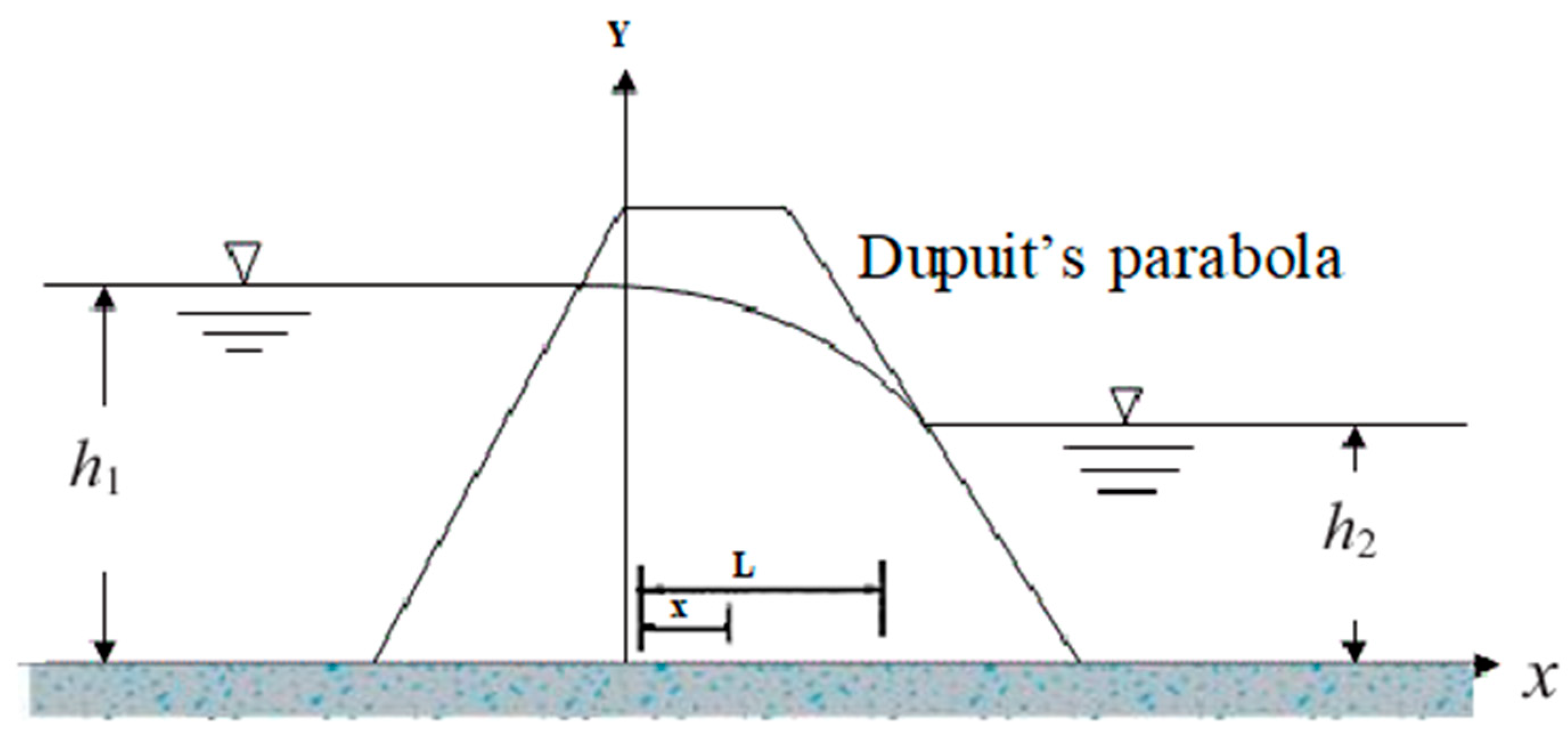

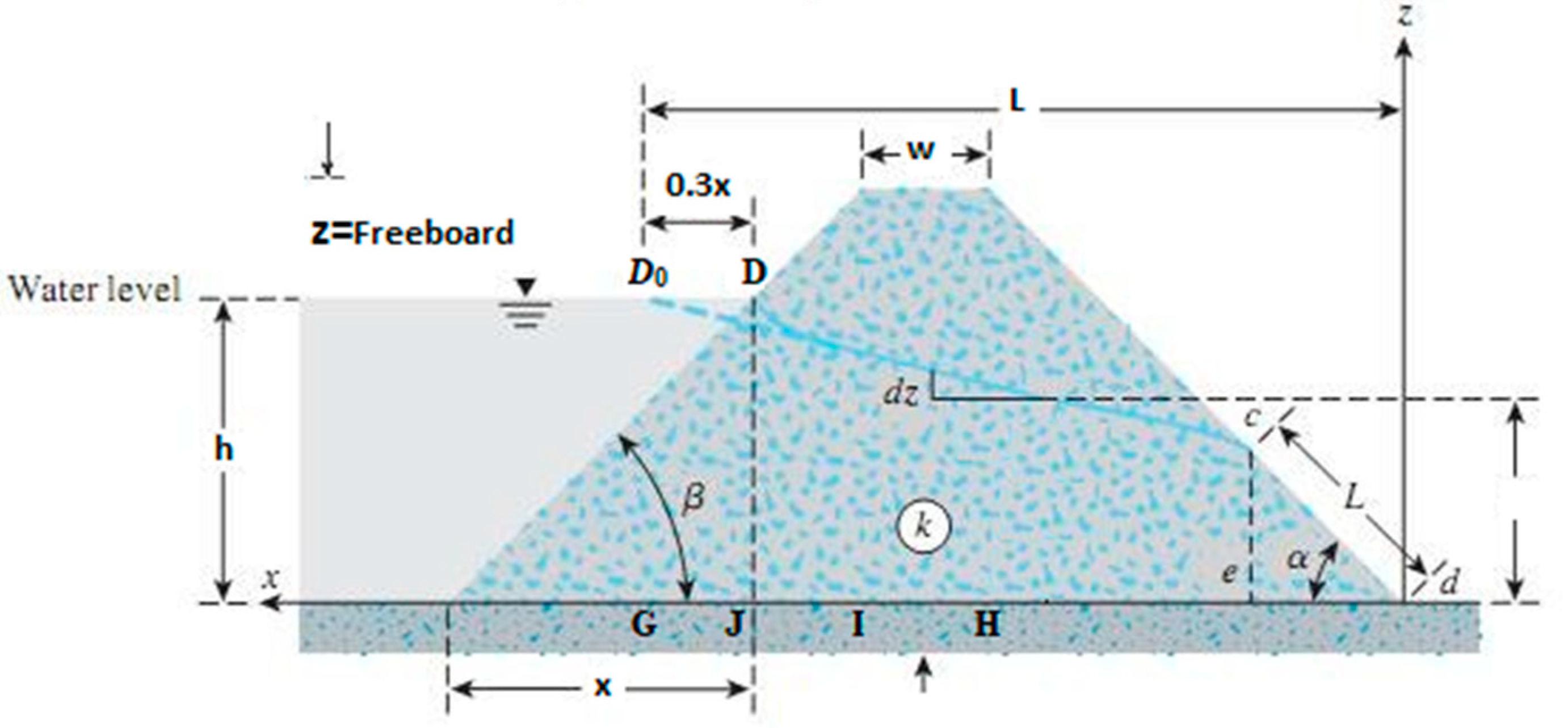

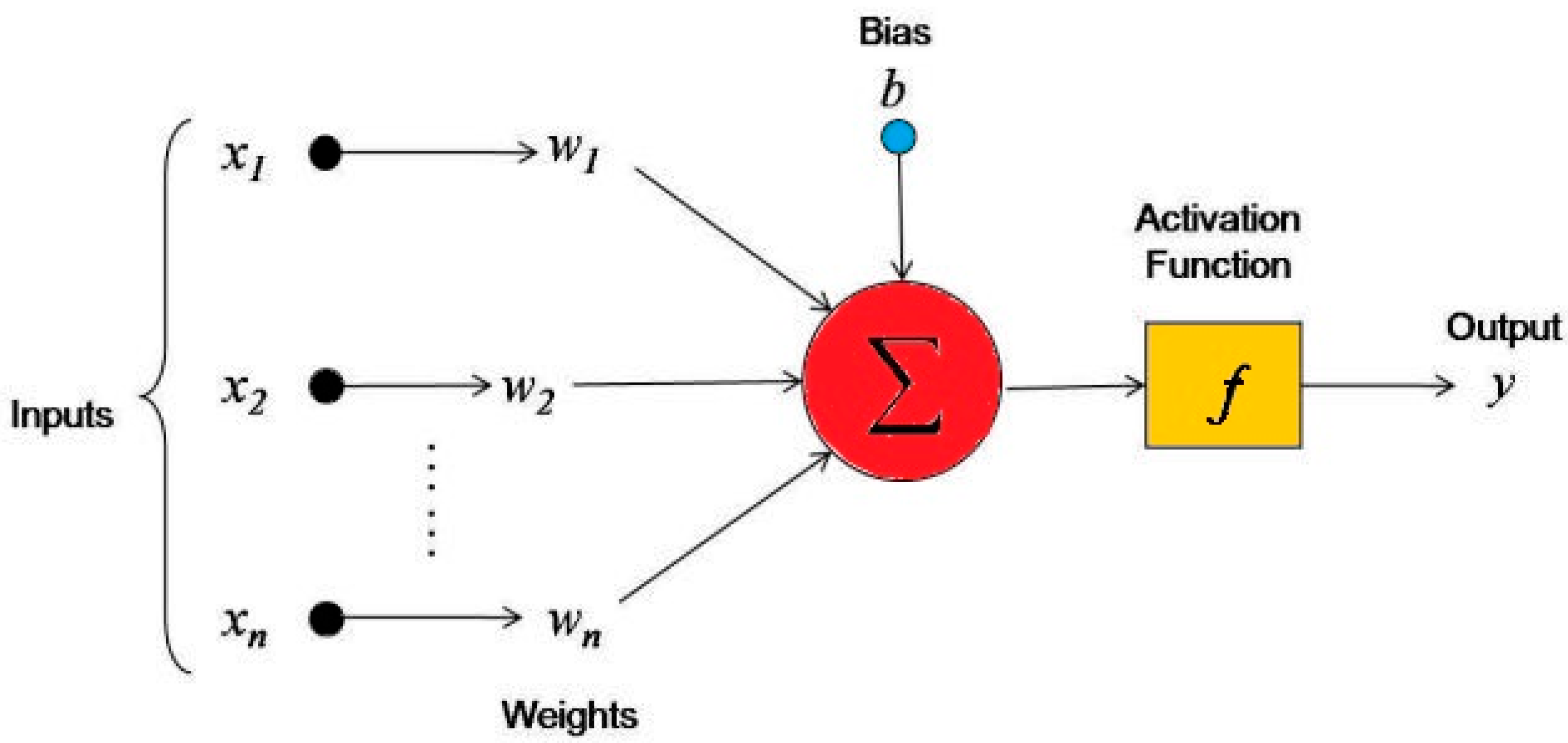
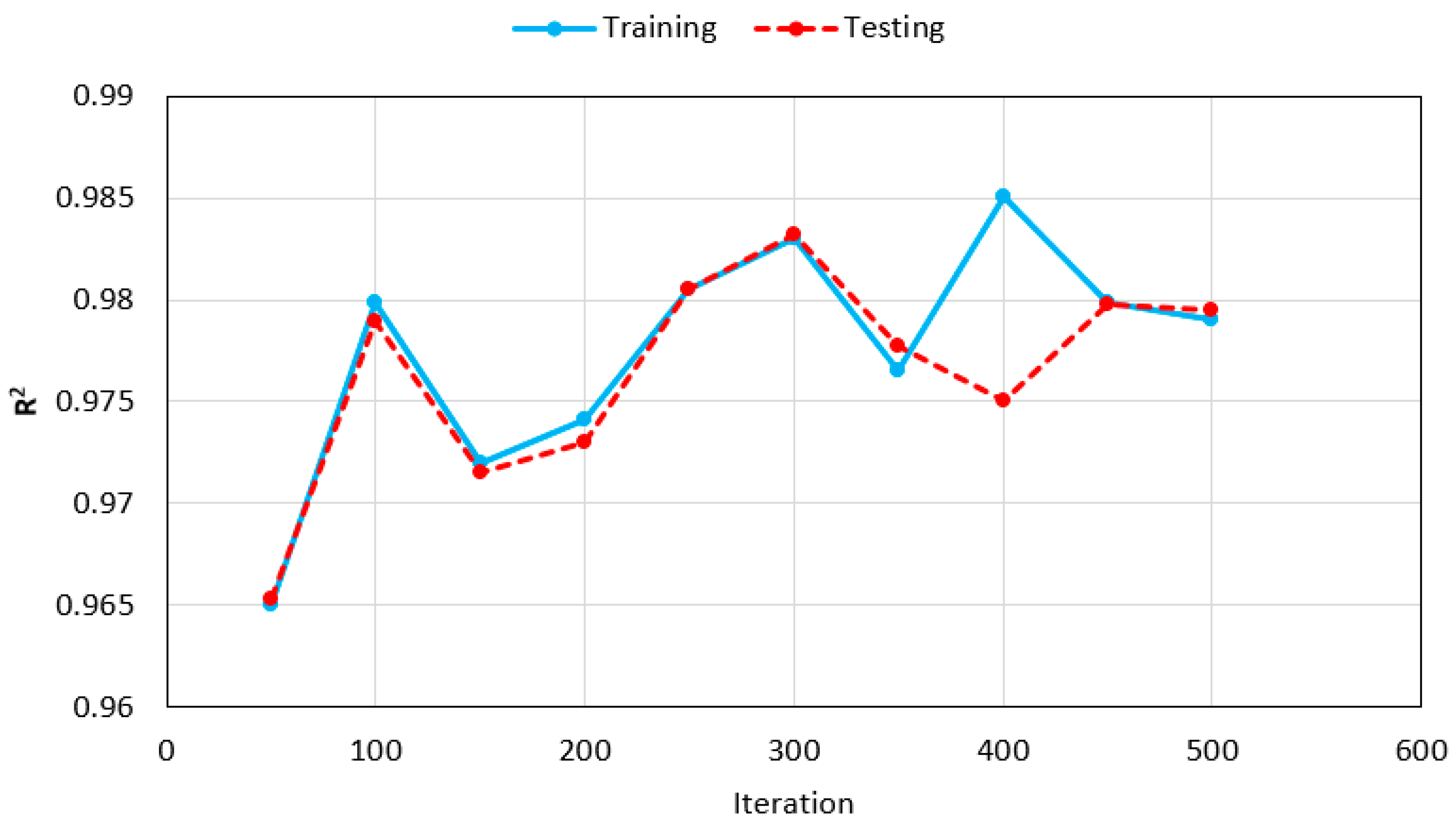
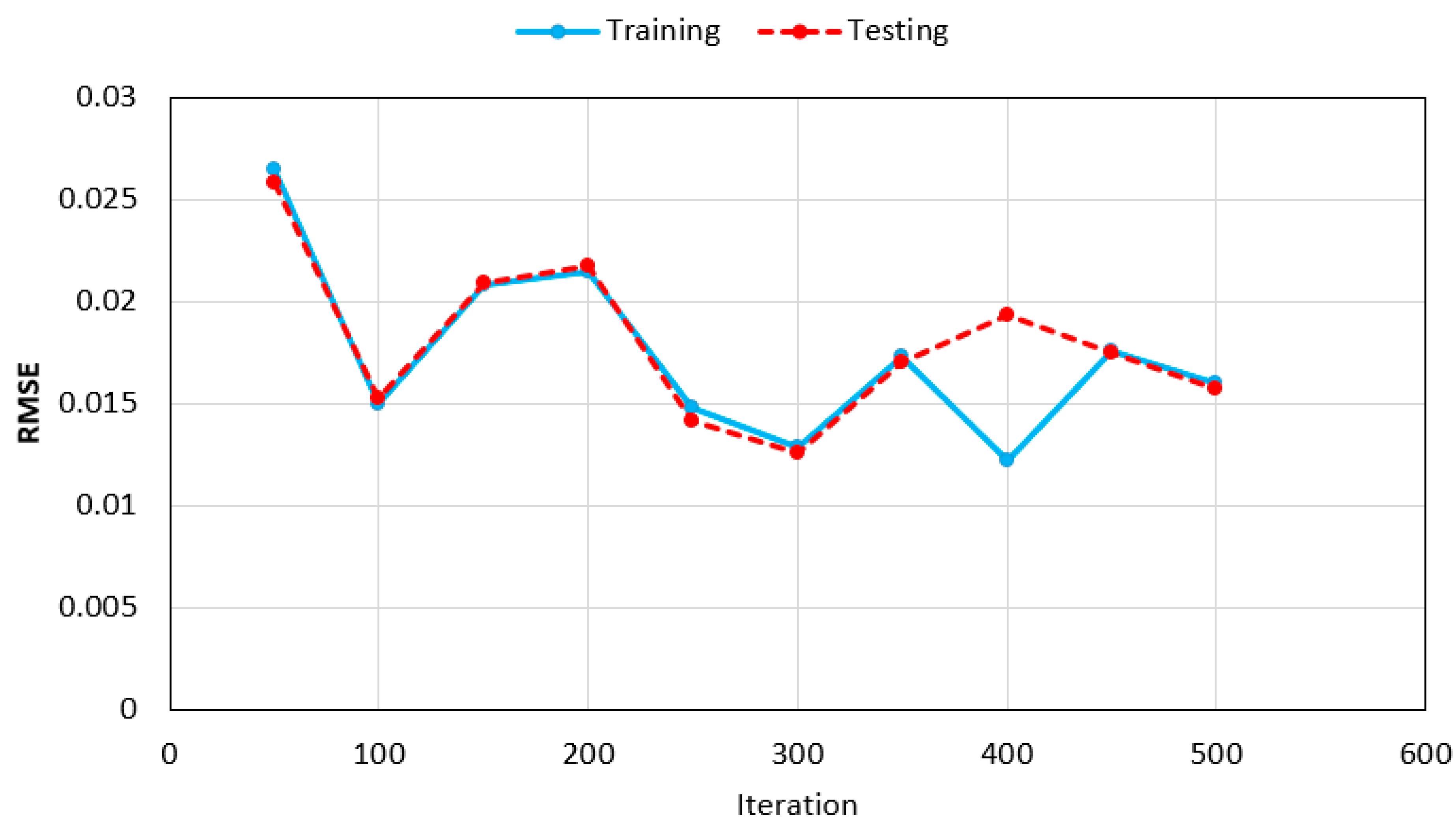

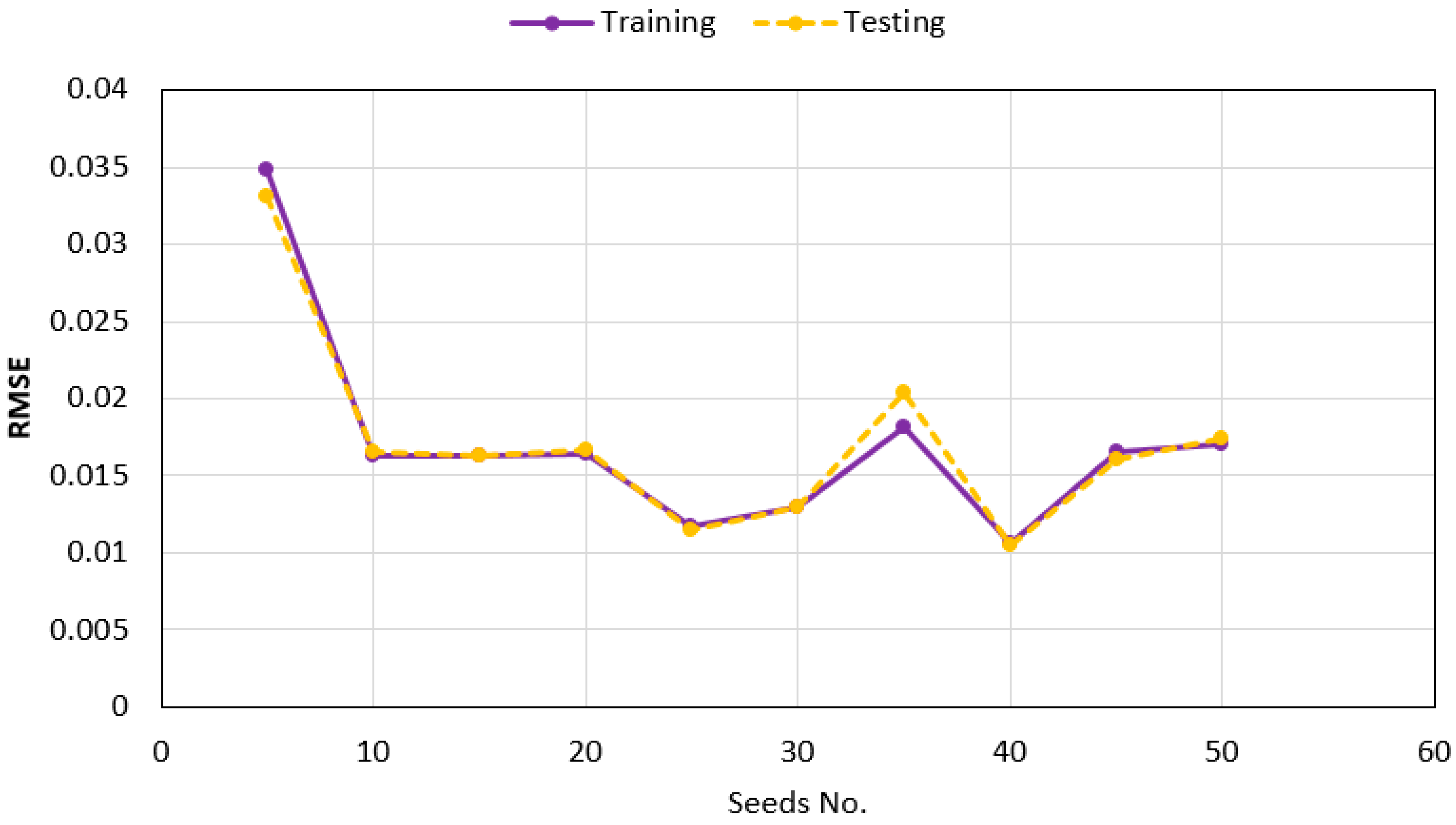
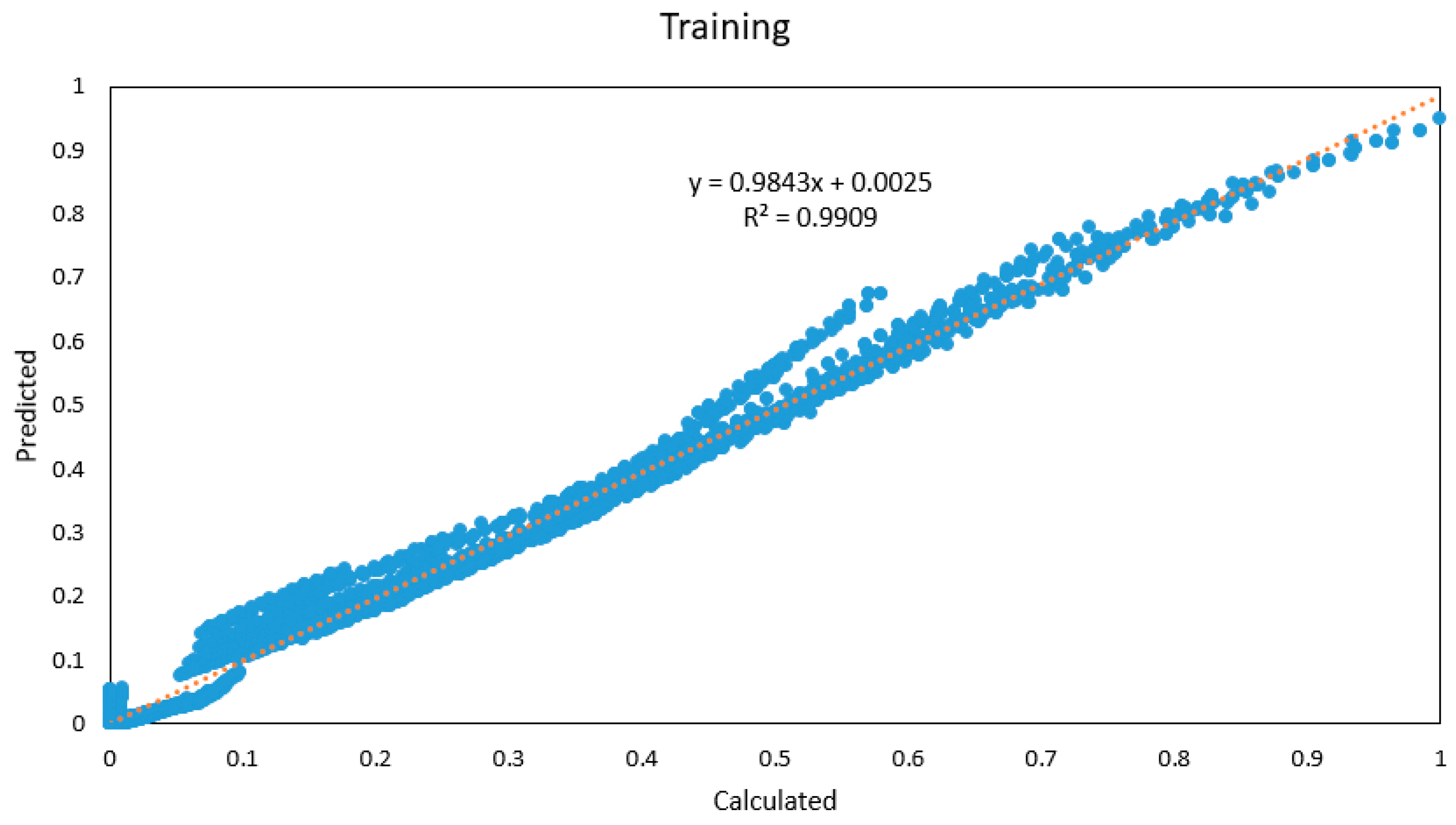
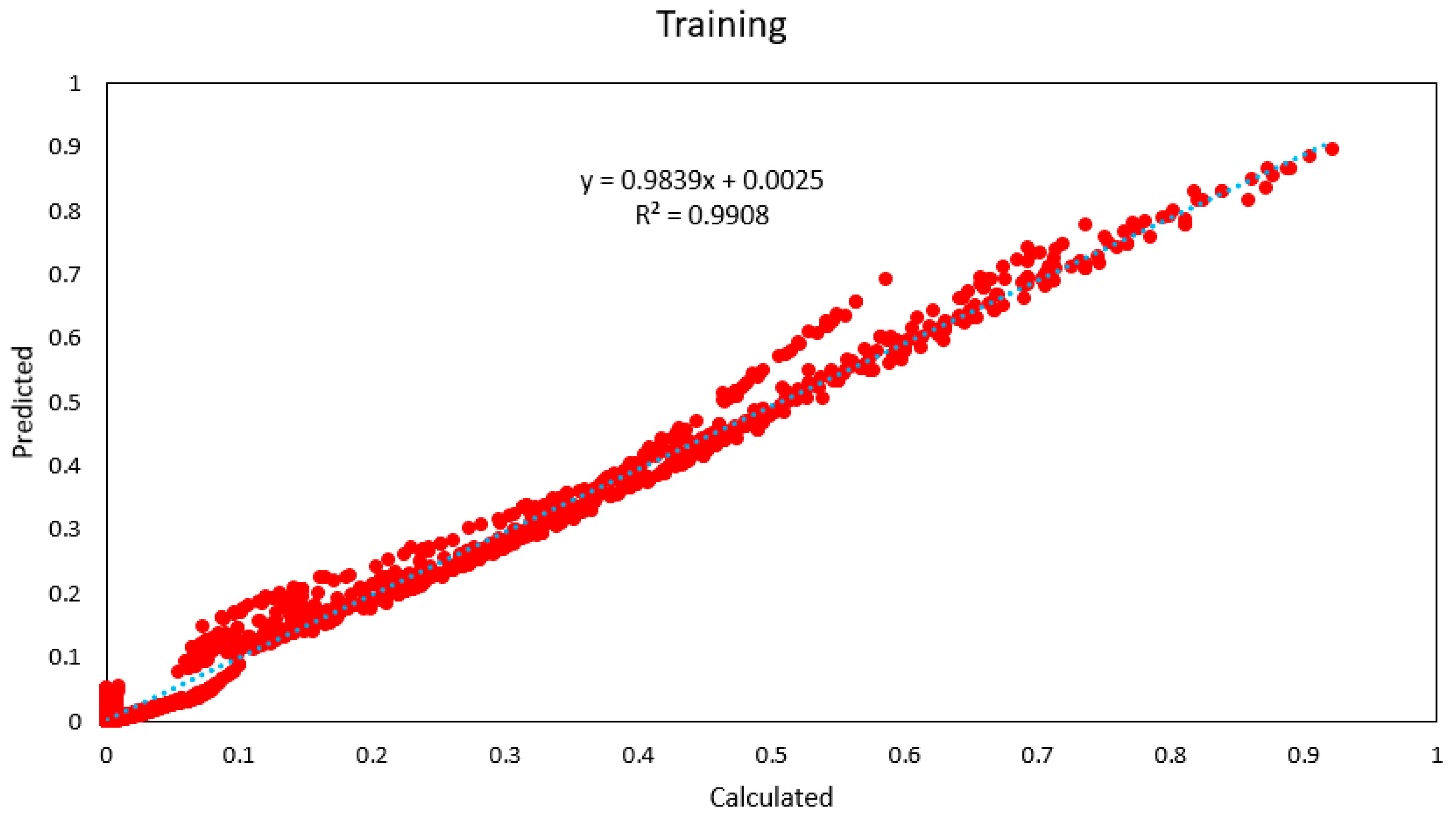
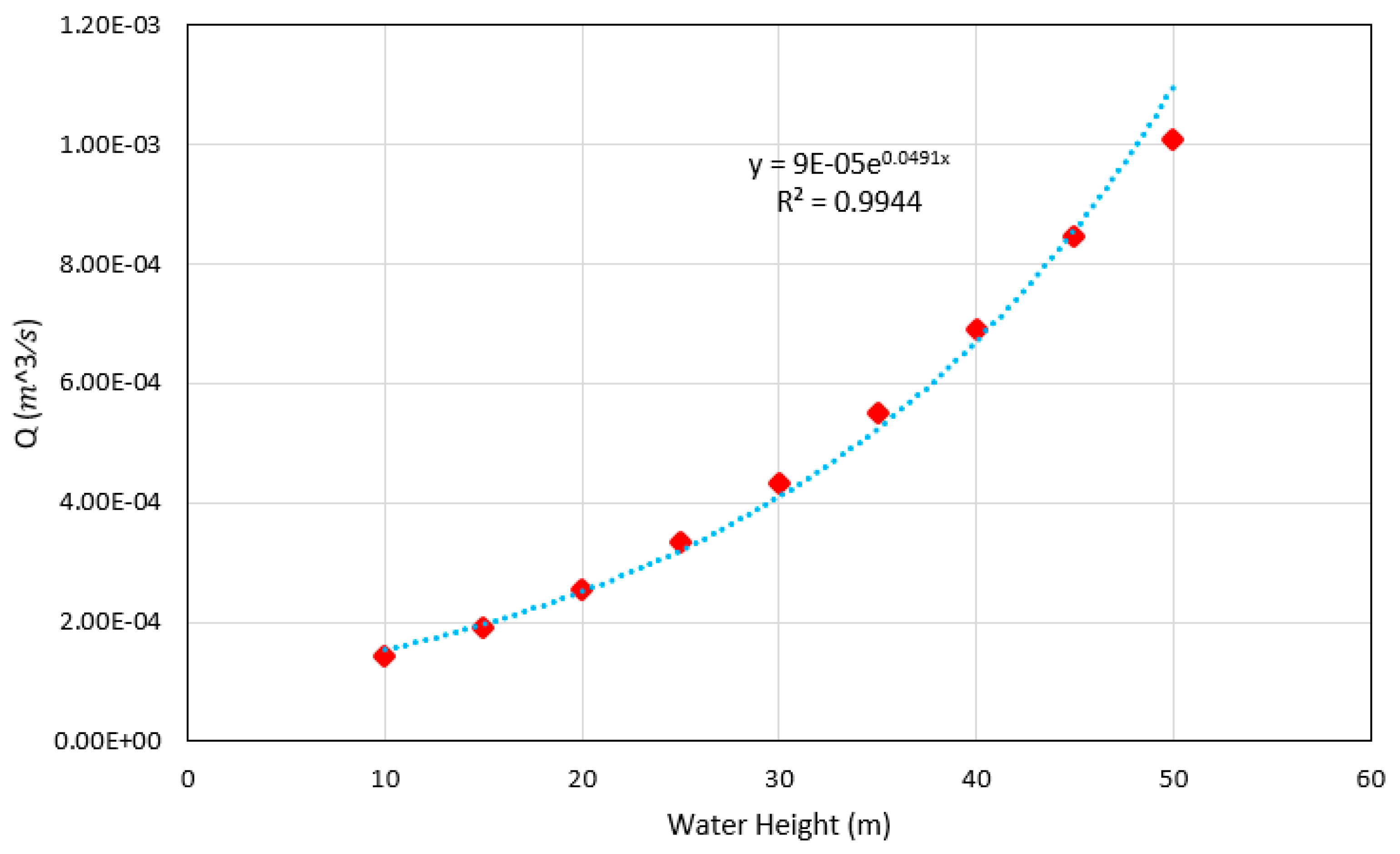
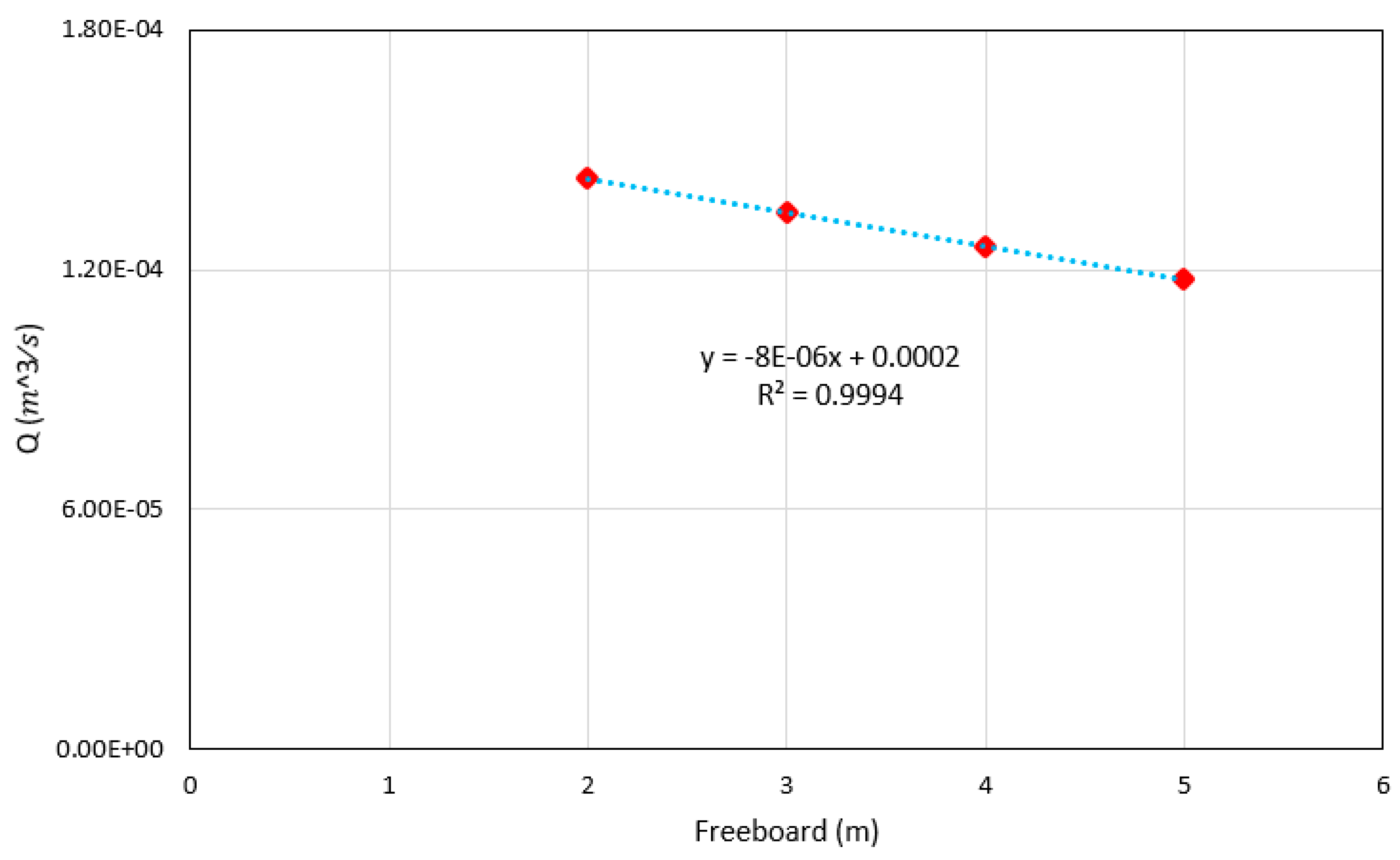
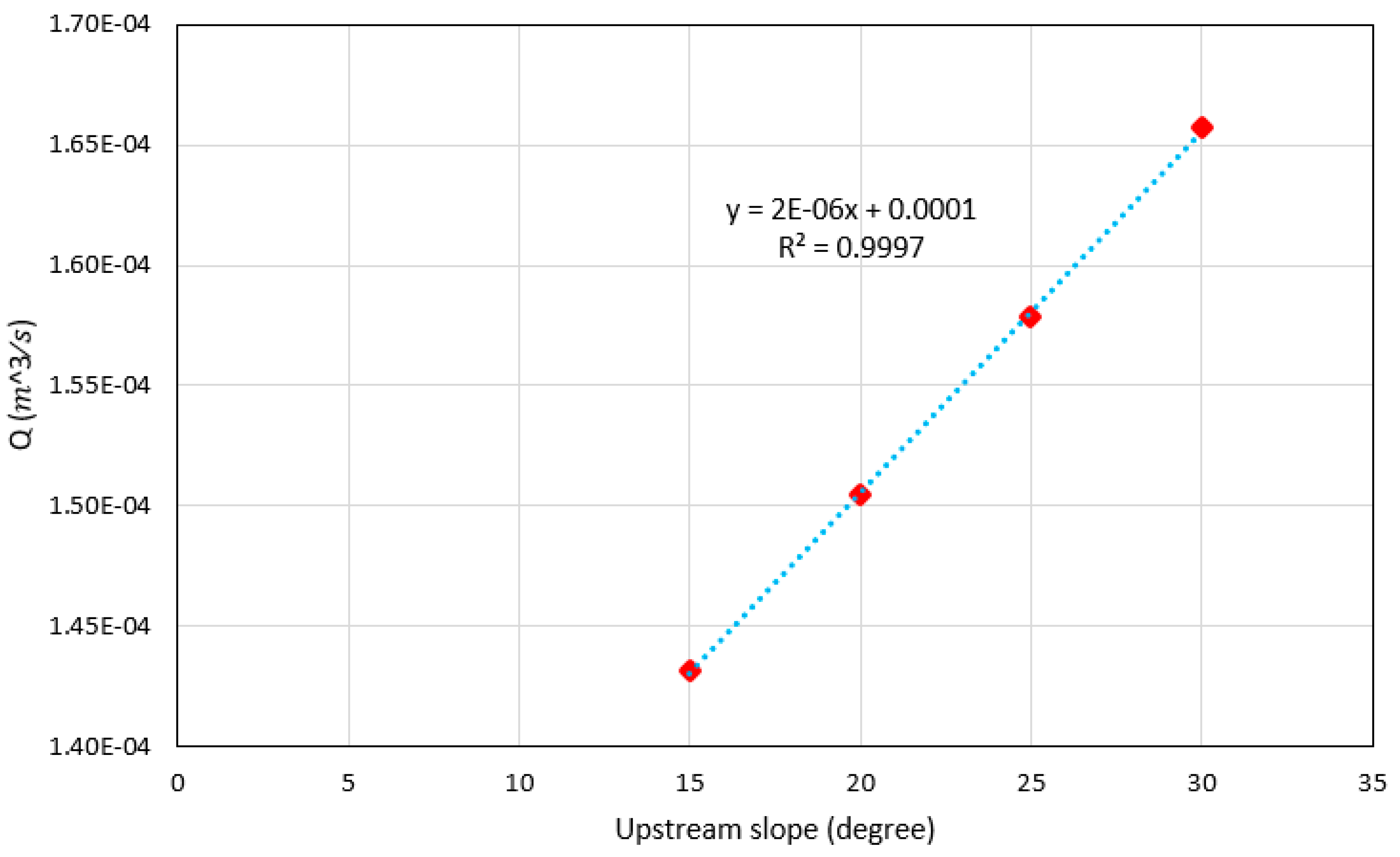
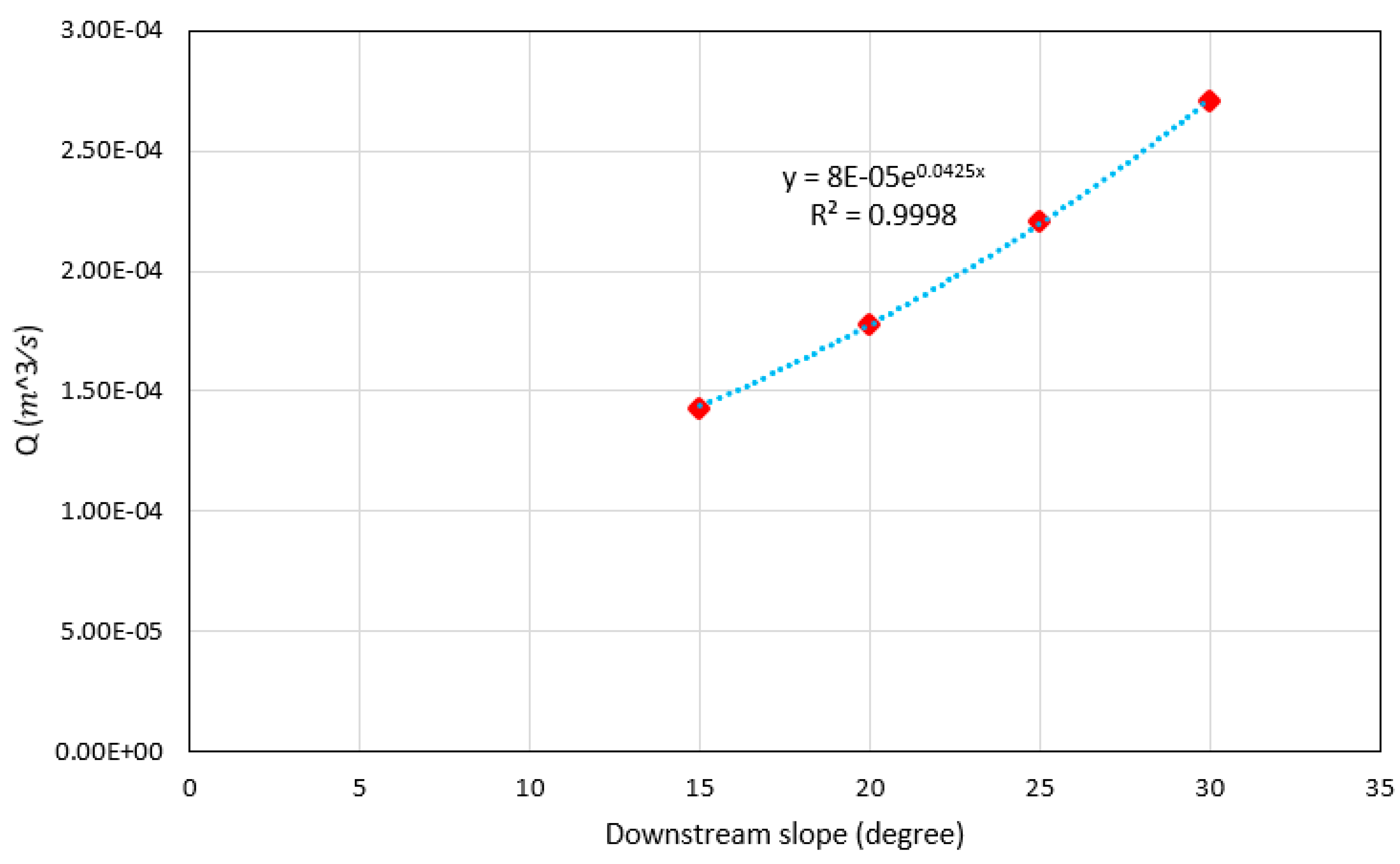
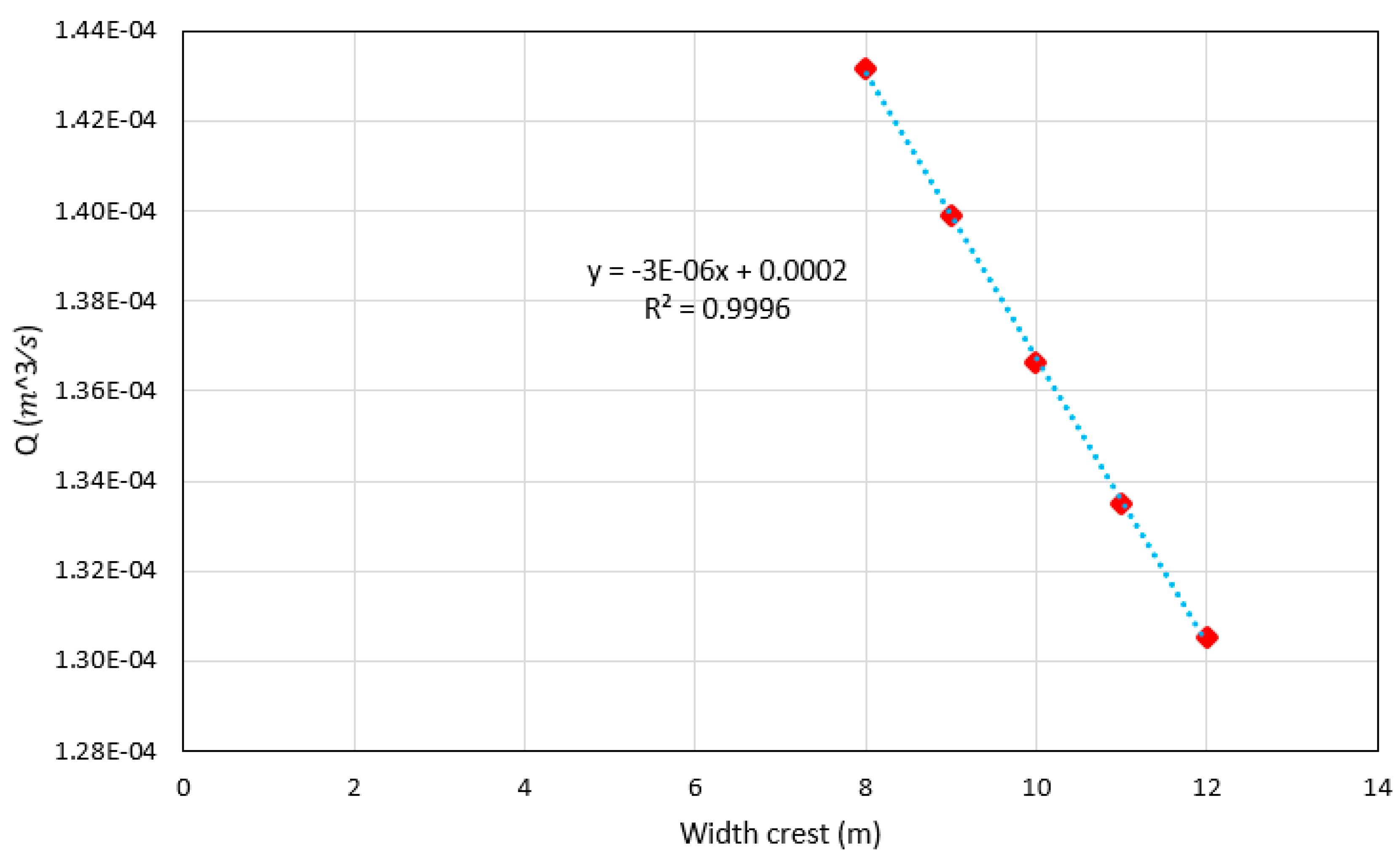
| Parameter | Abbreviation | Unit | Min | Max | Average | Std |
|---|---|---|---|---|---|---|
| Soil permeability coefficient | K | cm/s | 1 × 10−10 | 1 × 10−4 | 1.59 × 10−5 | 3.45 × 10−5 |
| Height water | HW | m | 10 | 48 | 29 | 10.89 |
| Freeboard | FB | m | 2 | 5 | 4 | 1.12 |
| Upstream slopes | β | degree | 15 | 30 | 23 | 5.59 |
| downstream slopes | α | degree | 15 | 30 | 23 | 5.59 |
| Width crest | WC | m | 8 | 12 | 10 | 1.63 |
| Seepage rate | Q | m3/s | 7.81 × 10−11 | 1.48 × 10−3 | 8.82 × 10−5 | 2.22 × 10−5 |
| Model No. | Structure | The Best R2 | |
|---|---|---|---|
| Training | Testing | ||
| T1 | 6-1-1 | 0.7925 | 0.8050 |
| T2 | 6-2-1 | 0.9126 | 0.9068 |
| T3 | 6-3-1 | 0.8738 | 0.8633 |
| T4 | 6-4-1 | 0.9018 | 0.9184 |
| T5 | 6-5-1 | 0.9378 | 0.9333 |
| T6 | 6-6-1 | 0.9140 | 0.9050 |
| T7 | 6-7-1 | 0.8919 | 0.8998 |
| T8 | 6-8-1 | 0.9071 | 0.9199 |
| T9 | 6-9-1 | 0.9155 | 0.9143 |
| T10 | 6-10-1 | 0.9241 | 0.9077 |
| Model No. | Structure | The Best R2 | |
|---|---|---|---|
| Training | Testing | ||
| E1 | 6-1-1 | 0.8460 | 0.8391 |
| E2 | 6-2-1 | 0.9025 | 0.8954 |
| E3 | 6-3-1 | 0.9257 | 0.9261 |
| E4 | 6-4-1 | 0.9059 | 0.9064 |
| E5 | 6-5-1 | 0.8648 | 0.8660 |
| E6 | 6-6-1 | 0.8813 | 0.8956 |
| E7 | 6-7-1 | 0.9103 | 0.9213 |
| E8 | 6-8-1 | 0.9052 | 0.9149 |
| E9 | 6-9-1 | 0.8666 | 0.8926 |
| E10 | 6-10-1 | 0.8860 | 0.8722 |
| Model No. | Structure | The Best R2 | |
|---|---|---|---|
| Training | Testing | ||
| S1 | 6-1-1 | 0.8571 | 0.8600 |
| S2 | 6-2-1 | 0.8708 | 0.8924 |
| S3 | 6-3-1 | 0.9231 | 0.8874 |
| S4 | 6-4-1 | 0.8962 | 0.9053 |
| S5 | 6-5-1 | 0.8862 | 0.9113 |
| S6 | 6-6-1 | 0.9055 | 0.8813 |
| S7 | 6-7-1 | 0.8834 | 0.9075 |
| S8 | 6-8-1 | 0.9017 | 0.8825 |
| S9 | 6-9-1 | 0.8876 | 0.9175 |
| S10 | 6-10-1 | 0.8668 | 0.8925 |
| Model No. | Structure | The Best R2 | |
|---|---|---|---|
| Training | Testing | ||
| L1 | 6-1-1 | 0.8513 | 0.8643 |
| L2 | 6-2-1 | 0.8757 | 0.8875 |
| L3 | 6-3-1 | 0.8521 | 0.8432 |
| L4 | 6-4-1 | 0.8852 | 0.8946 |
| L5 | 6-5-1 | 0.9023 | 0.8904 |
| L6 | 6-6-1 | 0.8938 | 0.8849 |
| L7 | 6-7-1 | 0.8759 | 0.9009 |
| L8 | 6-8-1 | 0.9052 | 0.8944 |
| L9 | 6-9-1 | 0.8707 | 0.8712 |
| L10 | 6-10-1 | 0.8802 | 0.8934 |
| The Parameters | Equation | R2 |
|---|---|---|
| Water height | Y = 9 × 10−5 | 0.9944 |
| Freeboard | Y = −8 × 10−6 x + 0.0002 | 0.9994 |
| Upstream slope | Y = 2 × 10−6 x + 0.0001 | 0.9997 |
| Downstream slope | Y = 8 × 10−6 | 0.9998 |
| Width crest | Y = −3 × 10−6 x + 0.0002 | 0.9996 |
© 2020 by the authors. Licensee MDPI, Basel, Switzerland. This article is an open access article distributed under the terms and conditions of the Creative Commons Attribution (CC BY) license (http://creativecommons.org/licenses/by/4.0/).
Share and Cite
Tang, D.; Gordan, B.; Koopialipoor, M.; Jahed Armaghani, D.; Tarinejad, R.; Thai Pham, B.; Huynh, V.V. Seepage Analysis in Short Embankments Using Developing a Metaheuristic Method Based on Governing Equations. Appl. Sci. 2020, 10, 1761. https://doi.org/10.3390/app10051761
Tang D, Gordan B, Koopialipoor M, Jahed Armaghani D, Tarinejad R, Thai Pham B, Huynh VV. Seepage Analysis in Short Embankments Using Developing a Metaheuristic Method Based on Governing Equations. Applied Sciences. 2020; 10(5):1761. https://doi.org/10.3390/app10051761
Chicago/Turabian StyleTang, Dongchun, Behrouz Gordan, Mohammadreza Koopialipoor, Danial Jahed Armaghani, Reza Tarinejad, Binh Thai Pham, and Van Van Huynh. 2020. "Seepage Analysis in Short Embankments Using Developing a Metaheuristic Method Based on Governing Equations" Applied Sciences 10, no. 5: 1761. https://doi.org/10.3390/app10051761
APA StyleTang, D., Gordan, B., Koopialipoor, M., Jahed Armaghani, D., Tarinejad, R., Thai Pham, B., & Huynh, V. V. (2020). Seepage Analysis in Short Embankments Using Developing a Metaheuristic Method Based on Governing Equations. Applied Sciences, 10(5), 1761. https://doi.org/10.3390/app10051761





